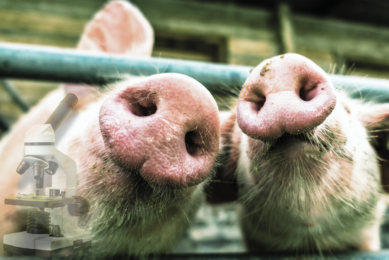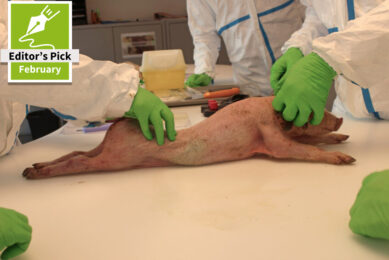Enhancing survival of larval shrimps with a Bacillus consortium
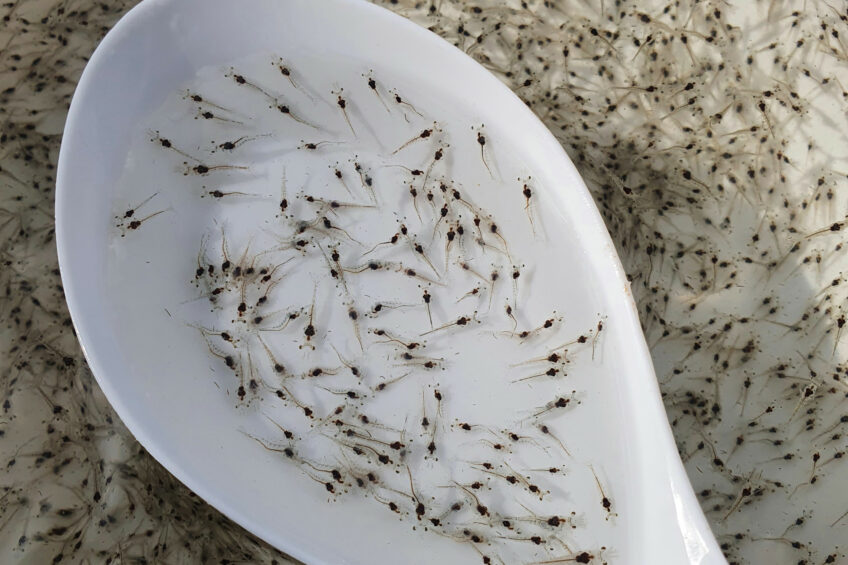
This article aims to provide insights into the critical role that probiotics play in ensuring successful shrimp hatchery operations while highlighting the effectiveness of Prozyta S against competitor brands on enhancing larval shrimp survival and Vibrio management in larval rearing tanks of whiteleg shrimp, Litopenaeus vannamei.
WORLD OF MICROBES SPECIAL 2024 – read all articles
The shrimp hatchery industry has witnessed significant advancements in recent years, particularly in the use of probiotics to enhance shrimp health and productivity. With extensive record of various emerging pathogens, usage of effective probiotic consortium is considered as the most effective, sustainable and safe approach towards combating the pathogens. Probiotics are live microorganisms that confer health benefits to the host, and their application in shrimp hatcheries has shown promising results in improving survival rates, controlling pathogens, and enhancing seed quality. Prozyta S is a unique Bacillus consortium specifically developed for larval and post-larval applications in shrimp aquaculture. The strains present are scientifically screened based on their efficacy to combat pathogens, bioremediation of the culture system and improve gut colonisation.
Experimental design
A study spanning 18 days was carried out in a commercial shrimp hatchery in India. The larval rearing tanks, each with a capacity of 10MT and an initial water volume of 3.5 MT, were stocked with 2 million nauplii (stage 5) of L. vannamei, which were fed microalgae (Chaetoceros spp.) and Artemia salina, followed by commercial larval feed starting from the Zoea II stage, in accordance with hatchery procedures. The culture water volume was gradually increased by 0.5 MT each day from nauplius 5 to PL1 stage, and thereafter, a 10% water exchange was implemented until harvest to ensure water quality was maintained. The experiment included 2 groups: a treatment group supplemented with Prozyta S at an everyday dosage of 1 ppm from nauplius 5 to PL9 stage (until packing), and an adjacent tank serving as the control, using competitor probiotic according to the hatchery’s standard practice. The necessary amount of the probiotic product was measured, mixed with adequate respective tank water for 3 minutes, then filtered through a 100µm nylon mesh before being evenly distributed across the larval rearing tanks. At the experiment’s outset and conclusion, the Vibrio concentration in the cultivation water was quantified using the spread plate method on TCBS agar plates in the hatchery’s in-house laboratory. The survival rate of post-larvae was assessed at the end of larval rearing (PL stage 8) using the scoop technique.
Figure 1 – Survival rate (%) of larval shrimps in PL tanks.
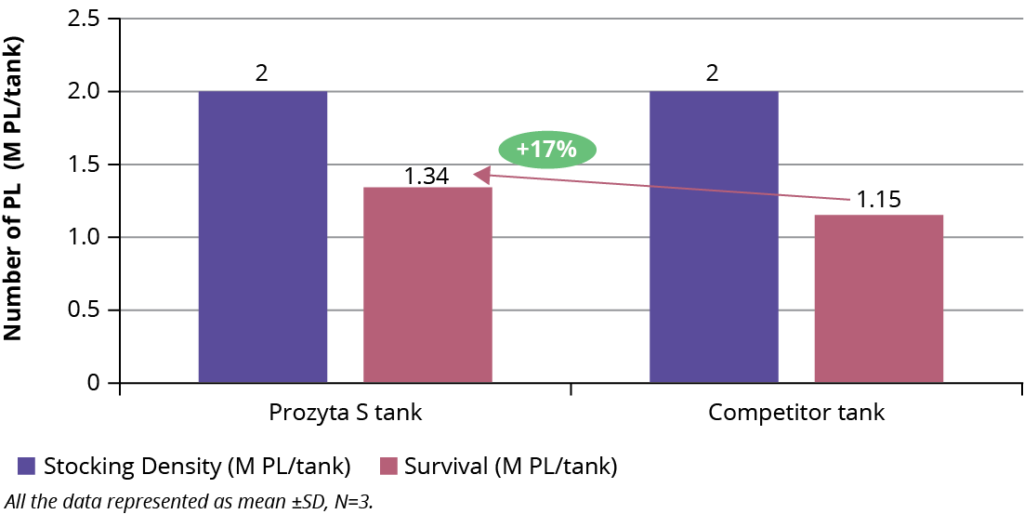
Results and discussion
Studies have reported that administering probiotics can significantly reduce the levels of Vibrio parahaemolyticus, a common pathogen associated with severe disease outbreaks in shrimp farms. According to the current study, shrimp tanks treated with the unique Bacillus consortium had an average survival of 1.34 million PL per tank, compared to 1.15 million PL per tank treated with a competitor brand. This is a 17% increase over the competitor brand (Figure 1). From 310 CFU/ml before application to 110 CFU/ml after application, the total Vibrio count showed a notable decline of 65% in the Vibrio colonies in the tanks treated with the unique Bacillus consortium. In contrast, the total Vibrio count decreased by 41% in the tanks treated with the competitor product, from 270 CFU/ml before treatment to 160 CFU/ml after application. Even though Vibrio was significantly reduced in both research tanks (Figure 2), the Prozyta S-treated tanks showed a further 24% improvement in controlling the Vibrio population, providing the shrimp larvae with lower levels of challenge and thereby improved survival. Usually, the survival in shrimp hatcheries differs based on the management practice and external environment. The unique Bacillus consortium helps in improving minimum 10% survival. This enhancement in survival of the post larvae might relate to the possible mechanism of action involving competitive exclusion, production of inhibitory metabolites, competition for nutrients, interference with quorum sensing, gut colonisation and breakdown of complex organic matter in the tanks, thus reducing pathogenic Vibrio count. The selected bacillus consortium of Prozyta S is thus superior to the standard practice used in the hatchery in the study.
Figure 2 – Total Vibrio population in PL tanks.
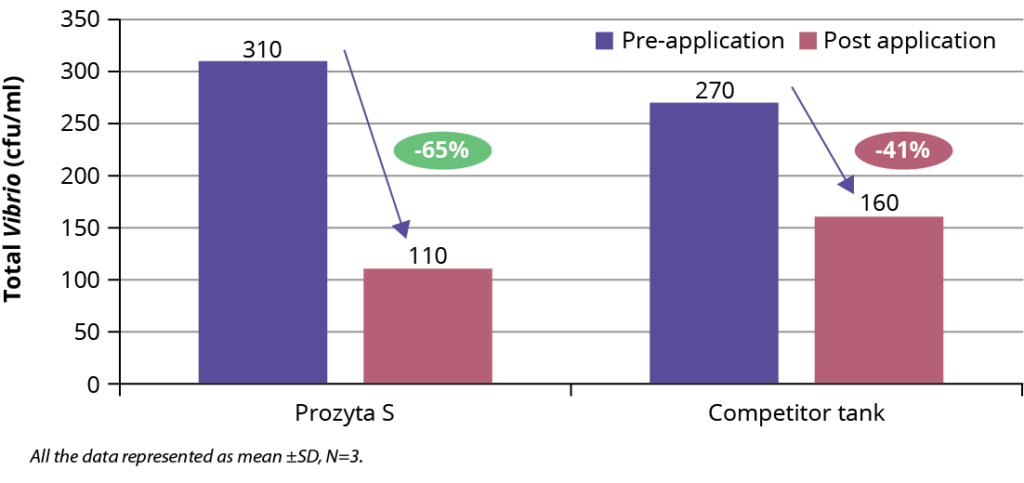
Return on Investment (ROI)
Prozyta S application increased PL survival by 17% on average, or around 1,90,000 PL per tank, and generated an additional USD$801 in revenue per PL tank. As a result, 1:7.3 ROI per tank was recorded.
Promising probiotic solution
The results emphasise that Prozyta S is an effective and promising probiotic solution for improving the survival of larval and post-larval shrimp and enhancing the maturation process during larval development. The incorporation of probiotics into shrimp hatchery practices offers substantial benefits for improving survival rates, controlling pathogens, and enhancing seed quality. As aquaculture continues to evolve towards more sustainable practices, the use of probiotics represents a viable solution for addressing common challenges faced by commercial shrimp hatcheries. By investing in high-quality probiotic products, hatcheries can achieve healthier shrimp populations and improved productivity, ultimately leading to greater profitability and sustainability within the industry.
References are available on request.




